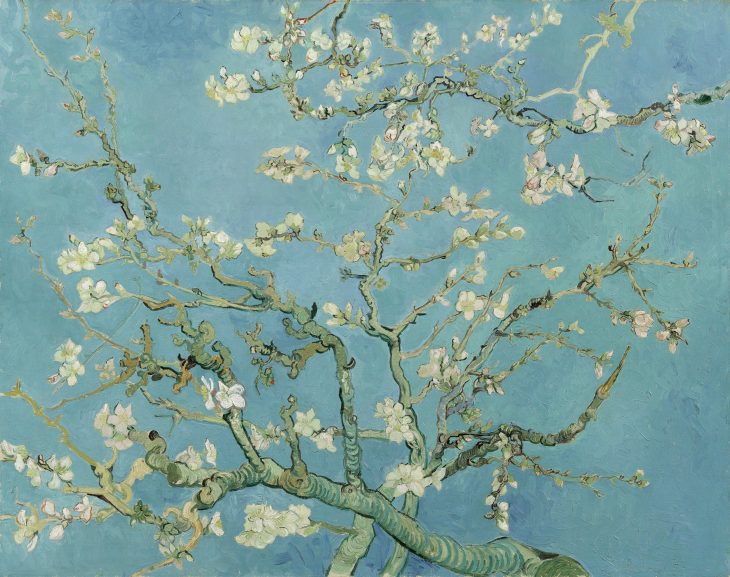Soon after his arrival in Paris in 1886, Van Gogh purchased no fewer than 660 brightly coloured, inexpensive woodcut prints from the dealer Siegfried Bing. He was trying to cash in on the craze for all things Japanese that had swept the French capital, perhaps with the hope of obtaining a measure of financial independence from his brother Theo. But Vincent’s venture turned out badly. Barely anything sold – a debt of 90 francs to Bing would remain unpaid at the artist’s death – and this motley bundle of what Bing himself had called ‘run-of-the-mill’ artworks came to comprise Van Gogh’s private Japanese collection. For the final five years of his life it was his most constant guide to the aesthetics of the Far East.
He would follow it, however, with devotion – and the route he took has been comprehensively retraced in the current exhibition at the Van Gogh Museum. Van Gogh’s diligent early copies, after prints in his collection, presage the prolific years in Arles, when the artist assimilated a range of Japanese pictorial ideas. His landscapes start to feature closely cropped objects, dominating the foreground and breaking up the composition into large planes of vivid colour. In Almond Blossom (1890), Van Gogh has us on our backs, gazing up at branches that fork across a sky of unadulterated blue. It was an unusual perspectival device in Western painting at the time and, in one of the exhibition’s many absorbing visual pairings, the nearby Bullfinch and Weeping Cherry (c. 1834) by Hokusai seems to offer a decisive clue to Van Gogh’s thinking.
Bullfinch and Weeping Cherry from a series known as Small Flowers and Birds, (c. 1834), Katsushika Hokusai. The Art Institute of Chicago.
But, in historical terms, the pairing is curiously deceptive. Van Gogh’s awareness of Japanese art was, of course, more extensive than his buying habits would suggest. At Bing’s, Van Gogh became well acquainted with masters like Hokusai and Hiroshige. He knew the prints he’d bought weren’t up to much; Bing had told him so. But their striking, almost acrid colours, achieved with cheap, synthetic pigments that Japan had only recently begun importing from the West, captivated him nonetheless. It was these he brought with him to Arles and, sequestered as he was in Provence when he painted Almond Blossom, Van Gogh could not have caught a glimpse of the Bullfinch for over two years.
It’s almost as though the comparison with Hokusai is suggested, only to be retracted in the same breath – and this display often gives the strange sensation of two separate exhibitions happening at once. On the one hand, there are the ukiyo-e (‘pictures of the floating world’) – a far finer collection than Van Gogh owned, and perhaps ever saw. On the opposing wall you observe Van Gogh gradually remaking his world into an image of Japan.
Self-Portrait (1888), Vincent Van Gogh. Harvard Art Museums/Fogg Museum
From the start, Van Gogh conceived of his retreat to Arles in peculiarly Japanese terms. He would later recall that, on the train journey south from Paris, he had ‘watched out the window to see if it was like Japan yet!’ – and he maintained this attitude once he arrived. Japan promised a new, more cheerful way of seeing. The point is made literal in the self-portrait of 1888 he dedicated to Paul Gauguin, in which he casts himself as a Buddhist monk. The artist gazes out through eyes that have been narrowed, in the final moments of painting, to an imagined Oriental slant.
Looking through such eyes, Van Gogh saw a blissfully bright otherwhere – from his first 12 months at Arles, only one of his dozens of landscapes depicts an overcast day. By seeing Provence as Japan he hoped to become ‘much happier and more cheerful’, as he confided to Theo that year. But to this ideal, reality could not measure up indefinitely. The arrival of Paul Gauguin in October 1888 heralded a period of exhausting rivalry that would leave Van Gogh mentally ill. In the spring of 1889, he painted Self-Portrait with Bandaged Ear (1889), depicting the moment after his self-mutilation. Here the artist’s stare holds you, with the stark knowledge that his Provençal dream has been extinguished, and on the wall behind him an anonymous print of Geishas in a Landscape appears, in a cruel juxtaposition of its carefree figures with those harrowed features.
Self-Portrait with Bandaged Ear (1889), Vincent Van Gogh. The Courtauld Gallery, London
With the original nearby, as though bodied forth from the canvas, the exhibition yields a rare moment when Van Gogh and his inspiration are brought indisputably together. You can see how Van Gogh has made the composition even more vertical, jerking Mount Fuji over to the right. With its high horizon and contrasting fields of red and blue marked out by bold contours, the print demonstrates all of the qualities that promised freedom to Van Gogh, a way out of Western melancholy. But seeing the print here, amid these scenes of Nipponised Provence it helped to inspire, you can’t help wondering what it means in its own right. It calls to mind yet stands apart from the fin-de-siècle iconography Van Gogh applied to it in earlier paintings. He thought these geishas were courtesans, emblems of Japan’s fabled, primitive libertinism – and so the most searching question the exhibition asks of you is the one it leaves unanswered. What kind of knowledge do you really gain of a place through images alone?
As though to simulate that same bedroom wall in Arles, a selection from Van Gogh’s own ukiyo-e collection has been thumbtacked up – using the corner-holes left by the artist’s pins – in the exhibition’s final room. It’s a remarkable window on Van Gogh’s Japan, and a fitting conclusion to a display which, throughout, reveals a one-way love affair with a floating world the artist never truly knew.
‘Van Gogh & Japan’ is at the Van Gogh Museum, Amsterdam, until 24 June.
